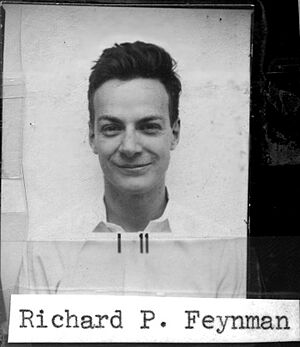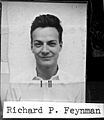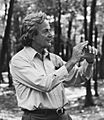Richard Feynman facts for kids
Quick facts for kids
Richard Feynman
|
|
|---|---|
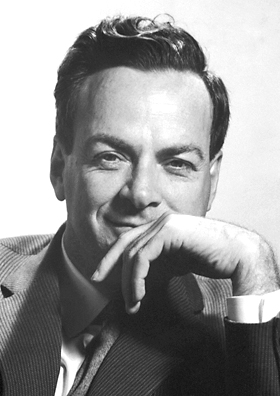
Feynman c. 1965
|
|
| Born |
Richard Phillips Feynman
May 11, 1918 New York City, U.S.
|
| Died | February 15, 1988 (aged 69) Los Angeles, California, U.S.
|
| Resting place | Mountain View Cemetery and Mausoleum, Altadena, California |
| Other names | Dick Feynman |
| Alma mater | |
| Known for |
See list
|
| Spouse(s) |
Arline Greenbaum
(m. 1941; died 1945)Mary Louise Bell
(m. 1952; div. 1958)Gweneth Howarth
(m. 1960) |
| Children | 2 |
| Awards |
|
| Scientific career | |
| Fields | Theoretical physics |
| Institutions | |
| Thesis | The Principle of Least Action in Quantum Mechanics (1942) |
| Doctoral advisor | John Archibald Wheeler |
| Doctoral students |
|
| Other notable students |
|
| Signature | |
 |
|
Richard Phillips Feynman (born May 11, 1918 – died February 15, 1988) was an American theoretical physicist. He was famous for his work on how tiny particles behave, especially in a field called quantum mechanics. He also helped create the theory of quantum electrodynamics. This theory explains how light and matter interact.
Feynman received the Nobel Prize in Physics in 1965. He shared it with Julian Schwinger and Shin'ichirō Tomonaga. This award was for their important work in quantum electrodynamics.
He invented a way to draw pictures, called Feynman diagrams. These diagrams help scientists understand and calculate how subatomic particles interact. During his life, Feynman became one of the most well-known scientists in the world. In 1999, a survey of top physicists ranked him as the seventh-greatest physicist ever.
During World War II, Feynman helped develop the atomic bomb. Later, in the 1980s, he became known to many people. He was part of the Rogers Commission. This group investigated the Space Shuttle Challenger disaster. Feynman also helped start the idea of quantum computing and introduced nanotechnology. He was a professor of theoretical physics at the California Institute of Technology (Caltech).
Feynman loved to share physics with others. He wrote books and gave lectures. One famous talk was about nanotechnology, called There's Plenty of Room at the Bottom. His college lectures were published in three books, The Feynman Lectures on Physics. He also wrote fun autobiographical books like Surely You're Joking, Mr. Feynman!.
Contents
Early Life and Education
Richard Feynman was born on May 11, 1918, in Queens, New York City. His father, Melville, encouraged him to ask questions and explore. His mother, Lucille, gave him a great sense of humor. As a child, he was very good at engineering. He even had a small lab at home and enjoyed fixing radios. This early interest showed his talent for understanding how things work.
When Richard was nine, his sister Joan was born. They were very close and shared a love for learning. Richard encouraged Joan's interest in astronomy. She later became an astrophysicist.
School Days and Learning
Feynman went to Far Rockaway High School. He was very smart in math and quickly moved to higher classes. By age 15, he had taught himself advanced math topics. These included trigonometry and calculus. He even created his own math symbols.
He applied to Columbia University but was not accepted. Instead, he went to the Massachusetts Institute of Technology (MIT). He first studied math, then electrical engineering, and finally settled on physics. He felt physics was "somewhere in between" the other two. As a student, he published two important papers. One of them led to what is now called the Hellmann–Feynman theorem.
In 1939, Feynman earned his bachelor's degree. He then went to Princeton University for his PhD. He got a perfect score on the physics entrance exam. His first major talk at Princeton was attended by famous scientists like Albert Einstein. He earned his PhD in 1942. His thesis helped create the ideas behind path integral formulation and Feynman diagrams.
Feynman married his high school sweetheart, Arline Greenbaum, in 1942. She was very ill with tuberculosis. He visited her often, even while working on important projects.
Working on the Atomic Bomb
In 1941, during World War II, Feynman worked on ballistics. After the attack on Pearl Harbor, he joined the Manhattan Project. This was a secret project to build the atomic bomb. He was still a young scientist without a graduate degree.
Feynman was sent to the Los Alamos Laboratory in New Mexico. This was where the atomic bombs were designed. He worked in the Theoretical Division and became a group leader. He helped develop a formula to calculate the power of a fission bomb. He also helped set up a system for using IBM punched cards for calculations.
He also worked at Clinton Engineer Works in Oak Ridge, Tennessee. This site had facilities for enriching uranium. Feynman helped create safety rules to prevent accidents. He even gave lectures to workers to explain the dangers of enriched uranium.
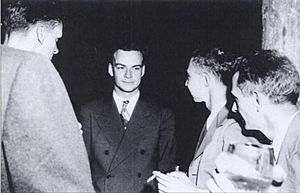
At Los Alamos, Feynman was known for his playful side. He would figure out the combinations to locks on cabinets and leave notes inside as a prank. He was also good friends with physicist Niels Bohr. Feynman was not afraid to challenge Bohr's ideas, which Bohr seemed to appreciate.
Feynman's wife, Arline, died on June 16, 1945. He was very sad but focused on his work. He was present at the Trinity nuclear test, the first explosion of an atomic bomb. He claimed to be the only person to watch it without special dark glasses.
Life After the War
After the war, Feynman became a professor at Cornell University. He felt a bit lost and struggled to focus on research. He started working on physics problems just for fun. One day, he saw someone toss a dinner plate in the air. This inspired him to study the physics of spinning objects. This work later became important for his Nobel Prize.
Quantum Electrodynamics
In the years after the war, physicists faced problems with quantum electrodynamics. This theory had mathematical flaws. Feynman, along with others, worked to fix these issues. He used his "path integral formulation" from his thesis.
He presented his ideas at conferences, but they were not always understood at first. His new Feynman diagrams were confusing to some. However, another physicist, Freeman Dyson, realized how brilliant Feynman's ideas were. Dyson helped explain Feynman's work, and soon, Feynman diagrams became a powerful tool for physicists. These diagrams made it much easier to understand and calculate particle interactions.
Moving to Caltech
In 1950, Feynman decided to move to the California Institute of Technology (Caltech). He spent a year in Brazil first, where he taught and learned to play the frigideira, a musical instrument. He loved playing bongo drums and often performed in musicals.
In 1952, he married Mary Louise Bell, but they later divorced. In 1960, he married Gweneth Howarth. They had a son, Carl, and adopted a daughter, Michelle. They also bought a beach house with his Nobel Prize money.
At Caltech, Feynman studied superfluidity in supercooled liquid helium. He explained how helium could flow without any friction at very low temperatures. This showed how quantum mechanics could be seen on a larger scale.
With Murray Gell-Mann, Feynman developed a model for weak decay. This helped explain how some particles change into others. He also worked on the strong interaction, which holds atomic nuclei together. He proposed the "parton model" to explain how protons and neutrons behave. These "partons" were later understood to be quarks and gluons.
Feynman also explored quantum gravity, trying to combine gravity with quantum mechanics. He worked on all four fundamental forces of nature: electromagnetic, weak, strong, and gravity. This is a rare achievement for a single scientist.
He was also interested in quantum computers. In the 1980s, he worked at Thinking Machines Corporation, helping to build early supercomputers. He thought about how to build computers based on quantum physics.
Teaching Physics
In the early 1960s, Feynman was asked to improve physics teaching at Caltech. He spent three years creating a series of lectures. These lectures became The Feynman Lectures on Physics. These books are still highly respected today. They help students gain a deep understanding of physics.
Feynman believed in clear thinking and understanding, not just memorizing facts. He was part of the California State Curriculum Commission. He was not impressed with the math textbooks, feeling they were too abstract for students.
In 1966, he gave a speech to science teachers. He encouraged them to teach students to think like scientists. This meant being curious, open-minded, and always questioning. He defined science as the process of doubting what is passed down and investigating the truth from experience.
In 1974, he gave a famous speech about "cargo cult science". He warned against pretending to do science without true honesty. He told students, "The first principle is that you must not fool yourself—and you are the easiest person to fool."
Surely You're Joking, Mr. Feynman!
In the 1980s, Feynman worked with Ralph Leighton to create an autobiography. It was published in 1985 as Surely You're Joking, Mr. Feynman!. The book became a best-seller. It was filled with funny stories and insights from his life.
Challenger Disaster Investigation

Feynman played a very important role in the Rogers Commission. This group investigated the 1986 Challenger disaster. He was at first hesitant to join, but his wife convinced him.
During a televised hearing, Feynman showed the problem with the shuttle's O-rings. He used a simple demonstration: he squeezed a piece of the O-ring material in a clamp and put it in ice water. The material became stiff and lost its flexibility in the cold. The commission found that the O-rings failed because of the unusually cold weather.
Feynman wrote about his experience on the commission in his book What Do You Care What Other People Think?. He found that NASA's engineers and managers had very different ideas about safety. Managers thought the chance of failure was 1 in 100,000. But engineers believed it was closer to 1 in 200. Feynman was upset that NASA used unrealistic safety estimates. He famously wrote, "For a successful technology, reality must take precedence over public relations, for nature cannot be fooled."
Awards and Later Life
Feynman received many awards for his work. In 1954, he won the Albert Einstein Award. He also received the Ernest Orlando Lawrence Award in 1962. In 1965, he shared the Nobel Prize in Physics. He was also recognized by the Royal Society and received the National Medal of Science.
In 1978, Feynman was diagnosed with a rare form of cancer. He had several operations. He died on February 15, 1988, at the age of 69. His last words were: "I'd hate to die twice. It's so boring."
Near the end of his life, Feynman wanted to visit Tuva, a country in the Soviet Union. He loved its culture and music. He received permission to travel there the day after he died. His daughter Michelle later made the trip for him.
Legacy and Influence
Richard Feynman's life and work have been shown in many ways. He has been played by actors in movies and plays. For example, Matthew Broderick played him in the 1996 film Infinity. Alan Alda starred as Feynman in the play QED.
Feynman is remembered in various ways. In 2005, the United States Postal Service issued a stamp with his picture. The main building for the Computing Division at Fermilab is named the "Feynman Computing Center." Apple Computer used his photos in their "Think Different" advertising campaign. Bill Gates has praised Feynman as a great teacher and helped make his lectures available online. At CERN, a street is named "Route Feynman" in his honor.
Images for kids
-
Feynman (center) with Robert Oppenheimer (immediately right of Feynman) at a Los Alamos Laboratory social function during the Manhattan Project
-
Feynman diagram of electron/positron annihilation
-
Richard Feynman at the Robert Treat Paine Estate in Waltham, Massachusetts, in 1984
-
The 1986 Space Shuttle Challenger disaster
See also
 In Spanish: Richard Feynman para niños
In Spanish: Richard Feynman para niños


